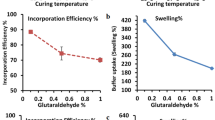Abstract
In a release study of alginate gel beads, swelling and erosion of the beads were observed at pH 6.8, whereas no swelling occurred at pH 1.2. The amount of released prednisolone (PL) was greater at pH 6.8 than at pH 1.2. The lower the ratio of mannuronic acid block to guluronic acid block in alginate, the slower the release of PL. An increase in loaded PL in the beads resulted in a slower release of PL. The decrease in bead size caused a rapid release of PL. The addition of sodium alginate propylene glycol ester elevated the extent of PL release. The plasma profile of PL showed sustained-release behavior after the oral administration of the beads to beagles. Furthermore, the correlation between in vitro release and in vivo absorption of PL for various alginate gel beads was evaluated using deconvolution and convolution methods. The in vivo absorption of PL was correlated with the PL release at pH 1.2, and it differed from that at pH 6.8. The release of PL from alginate gel beads in vivo appeared to occur under conditions that cause little swelling.
Similar content being viewed by others
REFERENCES
A. Haug and B. Larsen. Quantitative determination of the uronic acid composition of alginates. Acta Chem. Scand. 16:1908–1918 (1962).
A. Haug, B. Larsen, and O. Smidsrod. Studies on the sequence of uronic acid residues in alginic acid. Acta Chem. Scand. 21:691–704 (1967).
D. Thom, G. T. Grant, E. R. Morris, and D. A. Rees. Characterization of cation binding and gelation of polyuronates by circular dichroism. Carbohydr. Res. 100:29–42 (1982).
G. T. Grant, E. R. Morris, D. A. Rees, P. J. C. Smith, and D. Thom. Biological interactions between polysaccharides and divalent cations: The egg-box model. FEBS Lett. 32:195–198 (1973).
A. A. Badwan, A. Abumalooh, E. Sallam, A. Abukalaf, and O. Jawan. A sustained release drug delivery system using calcium alginate beads. Drug Dev. Ind. Pharm. 11:239–256 (1985).
C. K. Kim and E. J. Lee. The controlled release of blue dextran from alginate beads. Int. J. Pharm. 79:11–19 (1992).
N. Segi, T. Yotsuyanagi, and K. Ikeda. Interaction of calcium-induced alginate gel beads with propranolol. Chem. Pharm. Bull. 37:3092–3095 (1989).
K. Yamaoka, T. Nakagawa, and T. Uno. Statistical moments in pharmacokinetics. J. Pharmacokinet. Biopharm. 6:547–558 (1978).
K. Yamaoka, Y. Tanigawara, T. Nakagawa, and T. Uno. A pharmacokinetic analysis program (MULTI) for microcomputer. J. Pharmacobio-Dyn. 4:879–885 (1981).
K. Yamaoka and Y. Tanigawara. Maikon niyoru yakubutsusokudoron nyumon, Nankodo, Tokyo, 1983.
N. Katori, K. Okudaira, N. Aoyagi, Y. Takeda, and M. Uchiyama. In vitro and in vivo correlation for controlled-release formulation of d-chlorpheniramine maleate. J. Pharmacobio-Dyn. 14:567–575 (1991).
T. Higuchi. Mechanism of sustained-action medication. Theoretical analysis of rate of release of solid drugs dispersed in solid matrices. J. Pharm. Sci. 52:1145–1149 (1963).
T. Yotsuyanagi, T. Ohkubo, T. Ohhashi, and K. Ikeda. Calcium-induced gelation of alginic acid and pH-sensitive reswelling of dried gels. Chem. Pharm. Bull. 35:1555–1563 (1987).
O. Smidsrod and A. Haug. The effect of divalent metals on the properties of alginate solutions. I. Calcium ions. Acta Chem. Scand. 19:329–340 (1965).
A. Haug, S. Myklestad, B. Larsen, and O. Smidsrod. Correlation between chemical structure and physical properties of alginates. Acta Chem. Scand. 21:768–778 (1967).
A. Penman and G. R. Sanderson. A method for the determination of uronic acid sequence in alginates. Carbohydr. Res. 25:273–282 (1972).
D. A. Rees. Shapely polysaccharides. The eighth Colworth Medal Lecture. Biochem. J. 126:257–273 (1972).
S. Sugawara, T. Kawasaki, R. Kuroishi, T. Imai, and M. Otagiri. Characteristics of alginate gel beads and mechanism of drug release from alginate gel beads. 110th Annual Meeting of Pharmaceutical Society of Japan, Sapporo, August 1990, abstracts part 4, p. 118.
K. Tateshita, S. Sugawara, T. Imai, and M. Otagiri. Preparation and evaluation of a controlled-release formulation of nifedipine using alginate gel beads. Biol. Pharm. Bull. 16:420–424 (1993).
P. K. Maturu, V. K. Prasad, W. N. Worsley, G. K. Shiu, and J. P. Skelly. Influence of a high fat breakfast on the bioavailability of theophylline controlled-release formulations: An in vitro demonstration of an in vivo observation. J. Pharm. Sci. 75:1205–1206 (1986).
R. Dietrich, R. Brausse, G. Benedikt, and V. W. Steinijans. Feasibility of in-vitro/in-vivo correlation in the case of a new sustained-release theophylline pellet formulation. Arzneim.-Forsch./Drug Res. 38:1229–1237 (1988).
Author information
Authors and Affiliations
Rights and permissions
About this article
Cite this article
Sugawara, S., Imai, T. & Otagiri, M. The Controlled Release of Prednisolone Using Alginate Gel. Pharm Res 11, 272–277 (1994). https://doi.org/10.1023/A:1018963626248
Issue Date:
DOI: https://doi.org/10.1023/A:1018963626248




